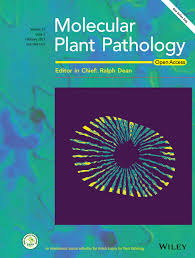Ver ítem
- xmlui.general.dspace_homeCentros e Institutos de InvestigaciónCICVyA. Centro de Investigación en Ciencias Veterinarias y AgronómicasInstituto de BiotecnologíaArtículos científicosxmlui.ArtifactBrowser.ItemViewer.trail
- Inicio
- Centros e Institutos de Investigación
- CICVyA. Centro de Investigación en Ciencias Veterinarias y Agronómicas
- Instituto de Biotecnología
- Artículos científicos
- Ver ítem
Overexpression of snakin-1 gene enhances resistance to Rhizoctonia solani and Erwinia carotovora in transgenic potato plants
Resumen
Snakin‐1 (SN1), a cysteine‐rich peptide with broad‐spectrum antimicrobial activity in vitro, was evaluated for its ability to confer resistance to pathogens in transgenic potatoes. Genetic variants of this gene were cloned from wild and cultivated Solanum species. Nucleotide sequences revealed highly evolutionary conservation with 91–98% identity values. Potato plants (S. tuberosum subsp. tuberosum cv. Kennebec) were transformed via Agrobacterium
[ver mas...]
Snakin‐1 (SN1), a cysteine‐rich peptide with broad‐spectrum antimicrobial activity in vitro, was evaluated for its ability to confer resistance to pathogens in transgenic potatoes. Genetic variants of this gene were cloned from wild and cultivated Solanum species. Nucleotide sequences revealed highly evolutionary conservation with 91–98% identity values. Potato plants (S. tuberosum subsp. tuberosum cv. Kennebec) were transformed via Agrobacterium tumefaciens with a construct encoding the S. chacoense SN1 gene under the regulation of the ubiquitous CaMV 35S promoter. Transgenic lines were molecularly characterized and challenged with either Rhizoctonia solani or Erwinia carotovora to analyse whether constitutive in vivo overexpression of the SN1 gene may lead to disease resistance. Only transgenic lines that accumulated high levels of SN1 mRNA exhibited significant symptom reductions of R. solani infection such as stem cankers and damping‐off. Furthermore, these overexpressing lines showed significantly higher survival rates throughout the fungal resistance bioassays. In addition, the same lines showed significant protection against E. carotovora measured as: a reduction of lesion areas (from 46.5 to 88.1% with respect to the wild‐type), number of fallen leaves and thickened or necrotic stems. Enhanced resistance to these two important potato pathogens suggests in vivo antifungal and antibacterial activity of SN1 and thus its possible biotechnological application.
[Cerrar]

Fuente
Molecular plant pathology 9 (3) : 329-338. (Mayo 2008)
Fecha
2008-05
Editorial
Wiley-Blackwell
ISSN
1364-3703
Formato
pdf
Tipo de documento
artículo
Palabras Claves
Derechos de acceso
Abierto
 Excepto donde se diga explicitamente, este item se publica bajo la siguiente descripción: Creative Commons Attribution-NonCommercial-ShareAlike 2.5 Unported (CC BY-NC-SA 2.5)
Excepto donde se diga explicitamente, este item se publica bajo la siguiente descripción: Creative Commons Attribution-NonCommercial-ShareAlike 2.5 Unported (CC BY-NC-SA 2.5)


